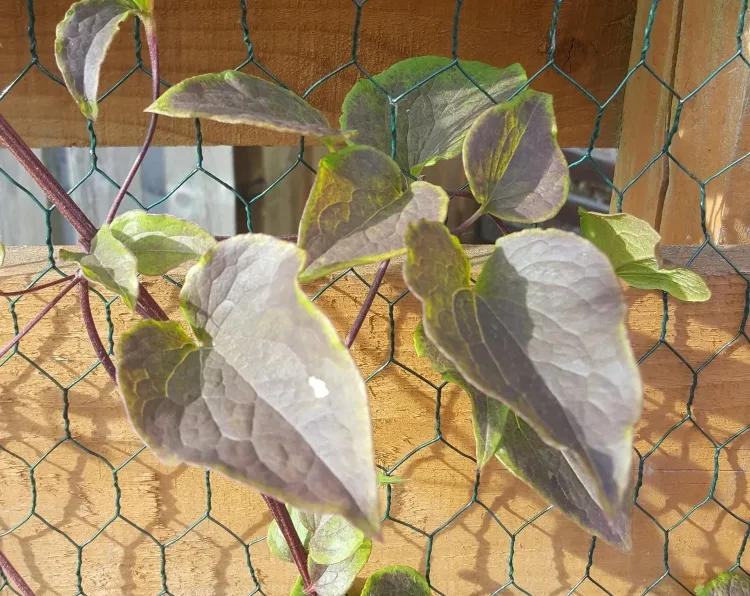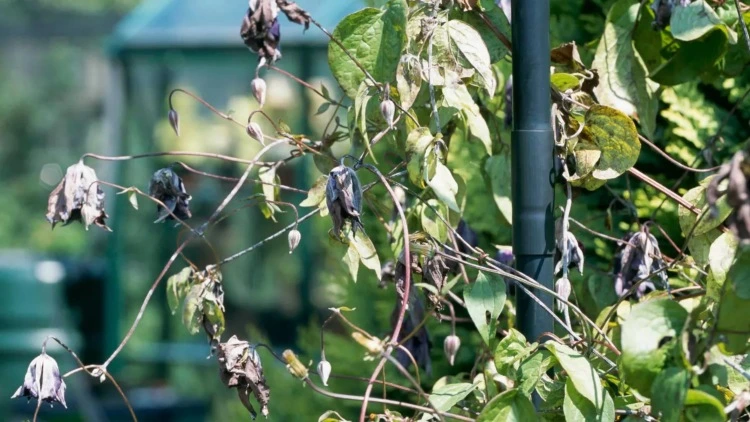Does your clematis have brown leaves, dried flowers and limp shoots? All the surefire signs of a fungal disease that often occurs in clematis: clematis wilt. If the symptoms are recognized early and care measures are taken, the plant can be cured. In the following we explain how you can recognize clematis wilt, what you can do about it, which home remedies help and how you can prevent a new infestation.
Does your clematis have brown leaves? That’s the reason!
Every hobby gardener who has clematis in the garden knows the consequences of clematis wilt. In fact, if the disease is detected too late, the whole plant can die. There are two varieties of clematis wilt and both are very dangerous.
The symptoms are very similar. The clematis suddenly and quickly begins to dry up, although it actually receives regular watering and is regularly fertilized.
This usually happens when the weather is changeable, with rapid succession of heat waves and summer rains. Sometimes the disease is favored by incorrect watering, for example if you water the clematis from above and the leaves are always wet. High humidity in combination with temperatures above 25 degrees Celsius promote the spread of the pathogen.
The clematis dried up? Fusarium clematis wilt

Die Fusarium Clematiswelke is caused by the fungus Coniothyrium clematidis. The fungus enters the plant tissue through cracks and cuts and blocks the pathways in the shoots. It is typical of the disease that the shoots wither and fall limp first. The plant then dries up at the point of entry. The leaves turn completely brown and begin to fall off quickly. In some cases, when the fungus spreads very quickly, the leaves remain green and fall off right away.
The Fusarium clematis wilt is caused by a typical fair-weather fungus that only spreads in the garden from mid-June. Since the pathogen penetrates deep into the plant tissue, conventional home remedies such as milk and fungicides from the garden center cannot help.

What to do At the first signs of the disease, a radical pruning can save the plant. Annual plants are particularly at risk – they have not yet developed their root system properly and have difficulty recovering from the cut. Additional fertilizers can also strengthen them and make them more resistant to diseases. The plant is watered less than usual after pruning. Too much water can lead to rot formation. After the plant sprouts again, you can gradually increase the watering.
The diseased plant parts that have been cut off must be disposed of with household waste. This prevents the fungus from spreading further in the garden.
Clematis has brown leaves: Recognize the Phoma clematis wilt

Phoma clematis wilt is caused by the pathogen Ascochyta clematidina. This fungus also attacks the clematis at high humidity and temperatures above 23 degrees Celsius. First, small brown spots can be seen on the leaves, which very quickly become larger. In the next few days, all leaves turn yellow-brown. Then the shoots, the flowers and all above-ground parts of the plant are attacked. After less than 20 days, the whole plant can die.
Hybrid flowers that have been bred for their large, delicate flowers are particularly at risk. There are also fungus-resistant varieties in which the disease only becomes known through a few small brown spots on the leaves.
What to do: Remove the diseased leaves immediately and treat the plant with fungicide. Normally we would suggest a home remedy as an alternative, but in this case using approved fungicides is really recommended. However, you can prevent a recurrence.
Prevent clematis wilt: These home remedies help
You can prevent an infestation by properly caring for the clematis. Here are some tips that can make your clematis more resistant to clematis wilt:
- Be sure to plant clematis under in the sun so that the root area is shaded and the soil does not heat up.
- Attach the climbing aid at a distance of approx. 15 cm from the house wall, fence or wall so that the air can circulate freely.
- Water the clematis from below and work a layer of sand into the soil to prevent waterlogging.
- Provide compost at the start of the gardening season, then fertilize with comfrey, goutweed, dandelion or onion manure in summer.
Does your clematis have brown leaves? Other possible causes

If the clematis develops brown leaves over a long period of time, then it may not be due to clematis wilt. In this case check:
- whether the drainage holes in potted plants are blocked and the excess water can drain off.
- whether the plant is in full sun – the clematis can hardly tolerate the strong midday sun and dry up quickly
- Are you using the right fertilizer? Nitrogen fertilizers can cause leaf discoloration.
- whether the plant is infested with pests. Spider mites can also promote leaf deformation and discoloration.
